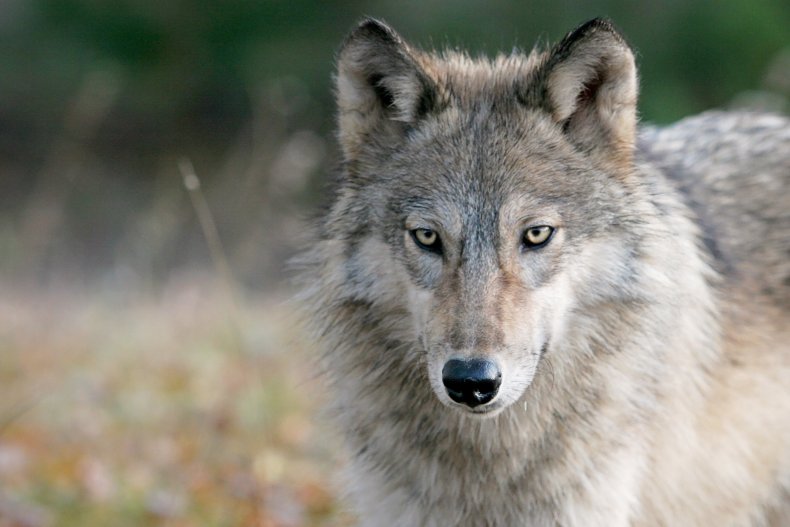A wolf in Minnesota has been spotted acting strangely in what experts have described as "not normal behavior."
According to a Facebook post from the Voyageurs Wolf Project (VWP), which studies wolves and their prey in the Greater Voyageurs Ecosystem, the young wolf is displaying "little-to-no-fear" of people, which is unusual for these animals.
"Some folks have tried to scare it off the road with little success," the project said in the post. "The wolf is not acting aggressively toward people or anything like that. However, its indifference toward people over a several-day period is not normal behavior."
The Greater Voyageurs Ecosystem includes the area in and around Voyageurs National Park—a vast protected area covering almost 220,000 acres in northern Minnesota near the Canadian border.
Latest population estimates from the Minnesota Department of Natural Resources suggest there are more than 2,600 wolves in in the state.
The VWP said Tuesday the weird wolf has been observed acing strangely repeatedly along roads near Ash River. On two occasions, the animal was spotted by people working for the project.
Some of the people who observed the wolf said it was chasing and eating grasshoppers near the road.
While grasshoppers are not a substantive meal for wolves, this is the leanest time of year for the predators and they will try and find food wherever they can, according to the VWP. Several images of the wolf in question show that the animal appears to be quite skinny, although the project said it looks in "decent condition."
"We have seen wolves that look much more thin than this wolf at this time of year," the VWP said.
It may seem counterintuitive that now is the leanest time of year for wolves to hunt, rather than the winter. The project said the key factor is the robustness of the animals they hunt, rather than prey availability.
"It is the vulnerability (or lack thereof) of prey, not the number of prey around that leads to pup starvation," the VWP said in a previous Facebook post. "While there are sufficient number of prey to sustain wolf packs in every part of the Greater Voyageurs Ecosystem, wolves cannot simply go out and kill prey whenever they desire at any time of year.
"Rather, prey must be vulnerable to predation for wolves to kill them. For example, in summer there could be 1,000 deer in a wolf's territory but if all the deer are in superb physical condition, then there would be very few deer that would be vulnerable or 'available' to wolves. Yet, in winter, when these 1,000 deer are in poor physical condition, there could be a large number of vulnerable deer available to wolves."

The VWP said just because the wolf observed over the past few days might be hungry does not explain its unusual indifference toward humans.
"Pretty much every wolf at this time of year is incredibly hungry and losing body weight," the VWP said. "Many are essentially starving slowly and trying to get through until fall and winter when hunting success increases. Yet, typical wolves do not act like this even when very hungry."
Some people in the Facebook comments suggested that the wolf may be suffering from an illness, but the VWP said it is not currently clear if this is the case and there could be "many possible explanations" for its behavior.
The VWP is advising anyone who sees the wolf to stay away from the animal and report the sighting to the organization.
"If you see the wolf, do not approach it, attempt to feed it, or anything else like that. Just let it be a wolf," the VWP said.
"In this case, [we] hope the wolf is just left alone and eventually goes back in the forest and behavior like a normal wolf and avoiding people."
Some people commenting on the wolf's pictures argued that the animal is actually a coyote not a wolf, based on its appearance. But the VWP said this was not the case.
"This animal has many physical traits that make it easy to ID this as a wolf including the overall size and body structure, the length of this animal's legs relative to its body size (coyotes are 'squattier' whereas wolves are lankier and have longer legs like this wolf), and the facial structure, which is blockier than a coyote," it said.
"Sometimes telling young wolves and coyotes apart can be challenging, especially when you don't get a good look. But in this instance, we got a really good look at this animal and many good pictures."
Many people also often misidentify small wolves as coyotes during the summer because wolves have very light, thin coats during this time, according to the VWP.
"Wolves look dramatically different with a light summer coat vs. a thick winter coat," the VWP said. "Additionally, wolves in our area are on the small size and do not look like the large wolves you see from western North America or northern Canada."
Newsweek has contact the Voyageurs Wolf Project for comment.
"behavior" - Google News
September 14, 2022 at 06:35PM
https://ift.tt/JQVSsuW
Minnesota Wolf Acting Strangely Towards People: 'Not Normal Behavior' - Newsweek
"behavior" - Google News
https://ift.tt/Iy8G4la
Bagikan Berita Ini














0 Response to "Minnesota Wolf Acting Strangely Towards People: 'Not Normal Behavior' - Newsweek"
Post a Comment